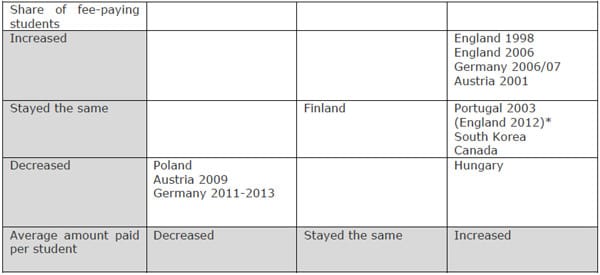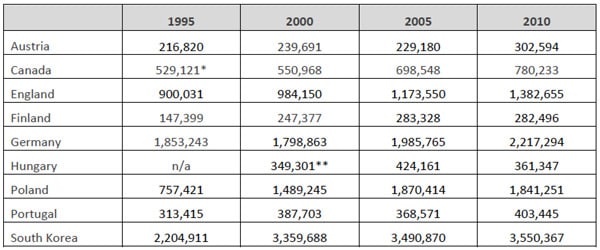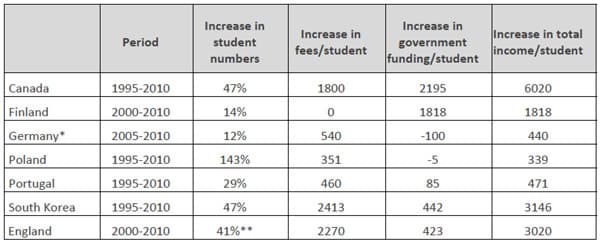Tuition increases should be paired with increased student aid, says new report
A recently released European Commission study finds that, when they are balanced with expanded financial aid for students, increases in tuition fees do not negatively impact higher education enrolment (unless the magnitude of the change is exceptional). Entitled Do changes in cost-sharing have an impact on the behaviour of students and higher education institutions?, the report makes clear that financial support for students - in the form of grants and/or loans - is crucial in offsetting the negative consequences of rising fees on university enrolments, particularly from vulnerable groups. Carried out by independent researchers for the European Commission, the study looks at the impact of changes in student fees in nine countries over the past 15 years. Data and policy changes, including the introduction of fees or changes in fee structures, were analysed in Austria, Canada, England, Finland, Germany, Hungary, Poland, Portugal, and South Korea. In particular, the research team examined different models of cost-sharing (that is, the split between public and private funding in higher education) and highlighted trends in participation and completion rates among various demographic groups. "Student fees are a reality for a large proportion of students in Europe – and a controversial issue,” said Androulla Vassiliou, European Commissioner for Education, Culture, Youth and Sport. “This study questions some common assumptions and provides valuable evidence for the on-going debate in the EU on how best to fund higher education to ensure institutions provide the highest quality of education to increasing numbers of students, while guaranteeing fair access."
Study methodology
A news releasefrom the European Commission explains, "The study was undertaken by Hanover-based Deutsches Zentrum für Hochschul - und Wissenschaftsforschung (DZHW) and Higher Education Strategy Associates (HESA) in Toronto. The study used both quantitative and qualitative data to examine the impact of changes in tuition fee policies on higher education applicants, students, and institutions. In each case, the research team used the available evidence to test common theories about the impact of tuition fees." More specifically, the study team considered four hypotheses with respect to tuition increases in higher education institutions (HEIs):
- Hypothesis A: As private funding increases, total revenue of HEIs increases;
- Hypothesis B: As the incentives to earn private funding increase, HEIs become more responsive to student demand;
- Hypothesis C: Increasing private funding has a negative effect on student demand;
- Hypothesis D: Increasing private funding affects student choice of how and what to study.
The report is part of the follow-up to the agenda for the modernisation of Europe’s higher education systems, adopted by the Commission in September 2011. “It does not advocate a particular system of funding or cost-sharing in higher education,” notes the official news release. “In Europe there is a diversity of funding systems; it is for Member States to decide which is the most appropriate for them.” The nine country case studies provide a variety of settings in which to study the effects of certain policy changes such as the introduction of, or increase, in fees. Countries were chosen for the study according to several criteria, such as:
- geographic coverage;
- economic strength;
- population size;
- enrolment numbers;
- share of students in private higher education;
- degree of public funding of institutions;
- changes to private funding;
- tuition fee policy;
- student financial aid provision.
The executive summary to the report adds:
“It was surmised that the countries with the biggest and most rapid shifts in tuition fee policy would be most interesting to study in order to best determine impact on student and HEI behaviour. For this reason the cases were split into ‘discontinuity countries’ (Austria, England, Germany and Portugal) and ‘continuity countries’ (Canada, Finland, Hungary, Poland and South Korea) for the analysis.”
The chart below offers an overview of tuition fee policy changes in the case study countries:

Key findings
The report sets out a number of general findings across education systems. One key finding which had an impact on the study was that data systems in several countries were found to be incomplete, making robust evidence-based conclusions a challenge in certain cases.
The study determined that the introduction of tuition fees typically makes the system better overall by increasing the total amount of resources available. The researchers also found, however, that these new resources were not always invested in ways that can be expected to improve the student experience. Revenues derived from increased fees, for example, are often dedicated toward expansion of the system or toward investments in research, rather than improvements geared to existing students.
Another key finding is that institutional behaviour is not necessarily impacted by changes in fee revenue. Other factors, such as competing financial or prestige incentives (the reputation of a long-standing academic programme, for example) also have an impact on how HEIs respond to their mission. Some institutions may avoid closing certain under-performing programmes or creating new programmes with wider appeal. Real change comes about, the report argues, by allowing institutions themselves to evolve in new directions.
How do fee increases impact student enrolment?
The report looks closely at how changes in institutional fee structures impact student enrolment. Almost without exception, the study found that participation rates rose throughout the analysis period, regardless of changes in fee policy. In some countries (notably Poland and South Korea), the introduction of fees quite clearly facilitated expansion of the higher education system.
The only clear-cut example of a fee increase affecting demand was England in 2012 (the timing of which was outside the main period of the study). The British government effectively removed a previous cap of £3,290 on tuition fees in 2012, allowing fees to increase up to a new ceiling of £9,000. This significant increase in fees did lead to a decrease in higher education participation in England in the years following.
The 2012 example aside, the impact of increased fees on accessibility and overall composition of the student body remains less clear. The authors note that due to insufficient data, it is difficult to conclude with certainty that fee increases will not affect certain demographic sub-groups based on family background, social class, ethnicity, or other factors.
They also point out that during the analysis period, fee increases did not affect the participation of women, and did not appear to have an impact on older students (with the notable exception of England after 2012).

Notably, the report contends that domestic enrolments remained unaffected during periods of fee increases in part because these increases were offset by additional funding to students in the form of grants and/or loans.
In England, for instance, increases in tuition fees were fully offset by loans. In Canada, changes were more or less offset by grants and changes to tax credits.
Aggregate data suggests that policies regarding fee increases cannot be taken in isolation, as students are sensitive and responsive to the combined affect of fee changes and concurrent changes to student aid structures.
Unsurprisingly, then, the report calls for cost-sharing strategies that take a more integrated approach by factoring in adjustments to institutional funding and student aid. The following table reflects this broader view of per-student funding impacts in a sample of the case study countries:

How do fee increases impact international students?
The tuition policy changes examined in the report did not explicitly address impacts of fee increases on international student enrolment in the countries under study. Caution is therefore warranted in applying the findings to questions of international tuition. We might imagine, however, that the broad conclusions of the study regarding the offsetting effects of expanded student aid in easing the impact of fee increases could often usefully factor in fee policies for international students as well. In addition, other studies have examined the impact of fee increases on international student behaviour. Last year, for example, we reported on some current cost analysis for study in Australia that concluded that cost remains one of the key drivers of international education in Australia and that high tuition costs present a barrier to Australia’s goal of increasing growth in international student numbers to 520,000 by 2020. Nevertheless, price sensitivity and the reality of an ever-more competitive global marketplace means that cost will continue to be an important differentiator for both countries and institutions. These factors could combine for a notable curb on tuition increases going forward, or at least encourage institutions toward more comprehensive fee policies that reflect shifts in institutional funding models and factor in questions of financial aid for students as well.
















